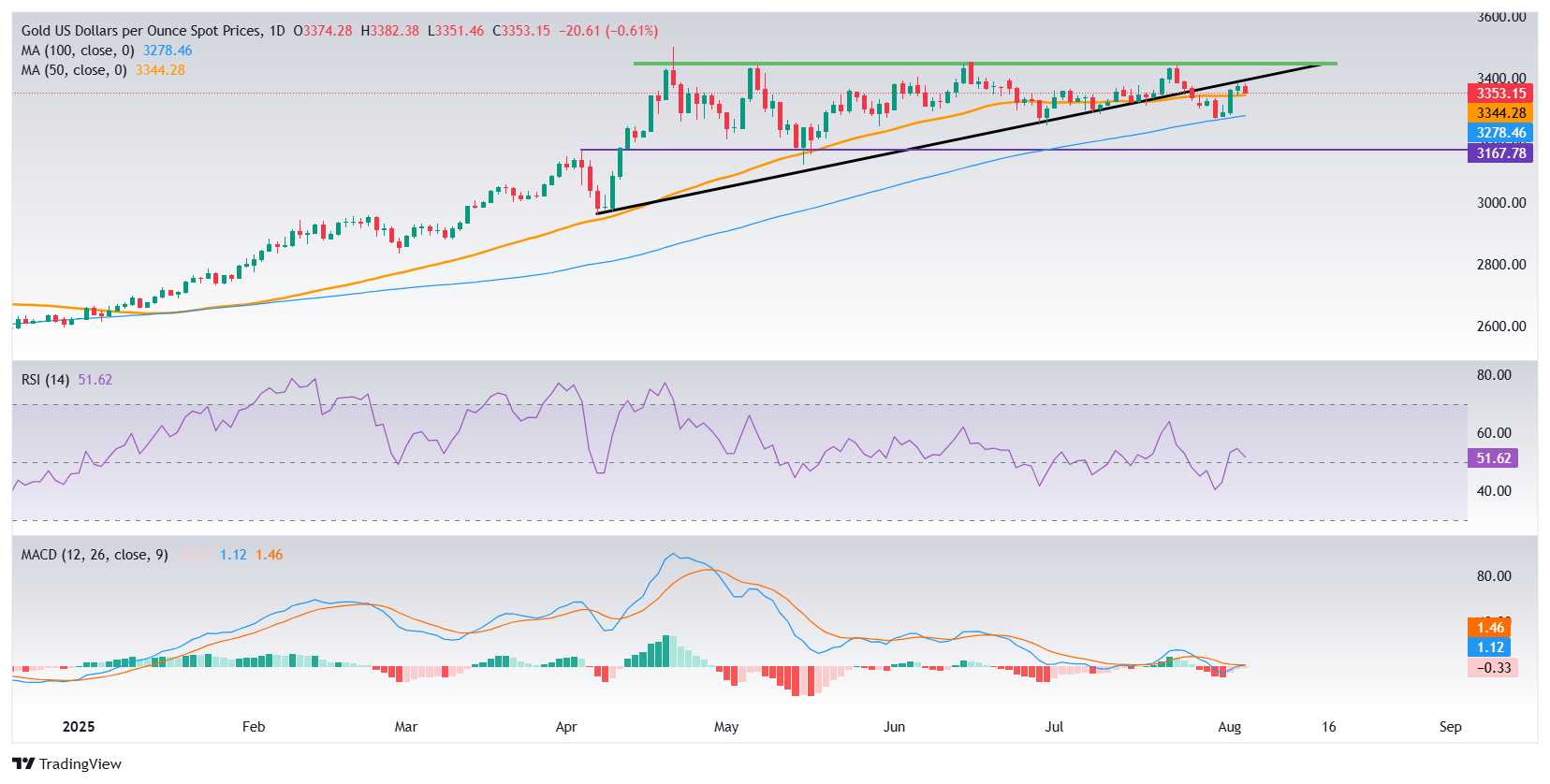Created
: 2025.08.05














![]() 2025.08.05 20:43
2025.08.05 20:43
Gold (XAU/USD) is drifting lower on Tuesday, giving back some of the gains after hitting a two-week high on Monday. The yellow metal is having a tough time pushing higher as investors lean into riskier assets, and a modest rebound in US Treasury yields from a one-month low is also weighing on sentiment.
Still, the pullback is shallow thanks to growing bets that the Federal Reserve (Fed) will cut interest rates in September, keeping both the US Dollar and Treasury yields under pressure and thereby limiting the downside in Gold.
At the time of writing, XAU/USD is ticking lower, hovering around $3,350 during European trading hours, down 0.60% on the day.
Investors are turning their attention to trade-related headlines, particularly developments surrounding US tariffs, which could inject fresh volatility into global markets.
On the data front, it is a relatively quiet day. The US ISM Services Purchasing Managers Index (PMI) and S&P Global Composite PMI are on deck. While they might spark some short-term moves, these are unlikely to shift expectations around the Fed's next move in September.
The broader market tone remains risk-on, limiting Gold's safe-haven appeal for now.
Markets across regions have rebounded strongly from last week's losses. The MSCI All-Country World Index snapped a six-day losing streak, while the MSCI Asia Pacific Index climbed 0.6%. Japan's Nikkei 225 gained 280 points on Tuesday. European stocks are also extending gains for the second straight session, with both the STOXX 50 and STOXX 600 up around 0.4%. Meanwhile, the FTSE 100 is trading near record highs, pushing toward the 9,150 mark. On Wall Street, major indices staged a sharp rebound on Monday. The S&P 500 surged 1.5%, ending a four-day losing streak, while the Dow Jones jumped 585 points and the Nasdaq Composite rose 1.9%.
Market optimism is being fueled by expectations that the Fed may resume cutting interest rates as early as September, following last week's soft US jobs report. According to the CME FedWatch Tool, markets are now pricing in a 92% probability of a rate cut at the September monetary policy meeting. These dovish expectations are keeping US bond yields and the US Dollar capped, which continues to act as a cushion for Gold prices despite near-term headwinds.

Gold (XAU/USD) is having trouble building on last week's rebound, with prices currently hovering near $3,350.
After breaking below an ascending triangle pattern and briefly hitting a one-month low last week, the metal found support just above the 100-day Simple Moving Average (SMA), suggesting bears still lack conviction.
The metal is now trading slightly above the 50-day SMA, which acts as immediate support, followed by the 100-day SMA. If prices break lower, the next targets could be around $3,275 and $3,200.
The Relative Strength Index (RSI) on the daily chart sits in neutral territory around 51, pointing to a lack of clear momentum. Meanwhile, the Moving Average Convergence Divergence (MACD) indicator remains below the zero line, but a flattening histogram hints that bearish pressure may be easing.
On the upside, if bulls can reclaim the broken triangle base and push decisively above $3,380, a move toward $3,450 is possible, potentially putting all-time highs back in sight.
Gold has played a key role in human's history as it has been widely used as a store of value and medium of exchange. Currently, apart from its shine and usage for jewelry, the precious metal is widely seen as a safe-haven asset, meaning that it is considered a good investment during turbulent times. Gold is also widely seen as a hedge against inflation and against depreciating currencies as it doesn't rely on any specific issuer or government.
Central banks are the biggest Gold holders. In their aim to support their currencies in turbulent times, central banks tend to diversify their reserves and buy Gold to improve the perceived strength of the economy and the currency. High Gold reserves can be a source of trust for a country's solvency. Central banks added 1,136 tonnes of Gold worth around $70 billion to their reserves in 2022, according to data from the World Gold Council. This is the highest yearly purchase since records began. Central banks from emerging economies such as China, India and Turkey are quickly increasing their Gold reserves.
Gold has an inverse correlation with the US Dollar and US Treasuries, which are both major reserve and safe-haven assets. When the Dollar depreciates, Gold tends to rise, enabling investors and central banks to diversify their assets in turbulent times. Gold is also inversely correlated with risk assets. A rally in the stock market tends to weaken Gold price, while sell-offs in riskier markets tend to favor the precious metal.
The price can move due to a wide range of factors. Geopolitical instability or fears of a deep recession can quickly make Gold price escalate due to its safe-haven status. As a yield-less asset, Gold tends to rise with lower interest rates, while higher cost of money usually weighs down on the yellow metal. Still, most moves depend on how the US Dollar (USD) behaves as the asset is priced in dollars (XAU/USD). A strong Dollar tends to keep the price of Gold controlled, whereas a weaker Dollar is likely to push Gold prices up.
![]()
Created
: 2025.08.05
![]()
Last updated
: 2025.08.05

FXStreet is a forex information website, delivering market analysis and news articles 24/7.
It features a number of articles contributed by well-known analysts, in addition to the ones by its editorial team.
Founded in 2000 by Francesc Riverola, a Spanish economist, it has grown to become a world-renowned information website.
We hope you find this article useful. Any comments or suggestions will be greatly appreciated.
We are also looking for writers with extensive experience in forex and crypto to join us.
please contact us at [email protected].
Disclaimer:
All information and content provided on this website is provided for informational purposes only and is not intended to solicit any investment. Although all efforts are made in order to ensure that the information is correct, no guarantee is provided for the accuracy of any content on this website. Any decision made shall be the responsibility of the investor and Myforex does not take any responsibility whatsoever regarding the use of any information provided herein.
The content provided on this website belongs to Myforex and, where stated, the relevant licensors. All rights are reserved by Myforex and the relevant licensors, and no content of this website, whether in full or in part, shall be copied or displayed elsewhere without the explicit written permission of the relevant copyright holder. If you wish to use any part of the content provided on this website, please ensure that you contact Myforex.
Myforex uses cookies to improve the convenience and functionality of this website. This website may include cookies not only by us but also by third parties (advertisers, log analysts, etc.) for the purpose of tracking the activities of users. Cookie policy